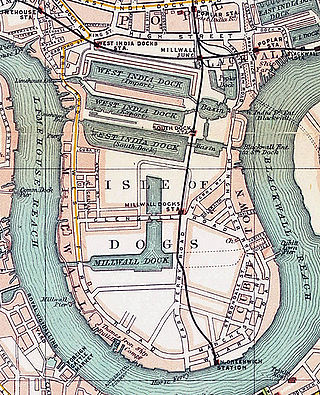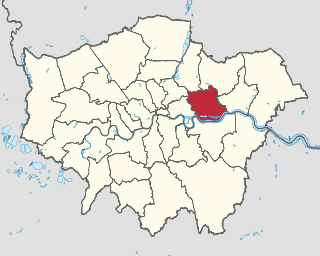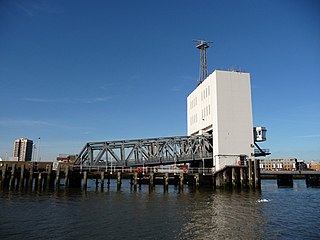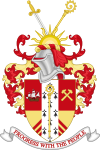
The Docklands Light Railway (DLR) is an automated light metro system primarily serving the redeveloped Docklands area of London and providing a direct connection between London's two major financial districts, Canary Wharf and the City of London. First opened on 31 August 1987, the DLR has been extended multiple times, giving a total route length of 38 km. Lines now reach north to Stratford, south to Lewisham, west to Tower Gateway and Bank in the City of London financial district, and east to Beckton, London City Airport and Woolwich Arsenal. Further extensions are being considered.

London Docklands is the riverfront and former docks in London. It is located in inner east and southeast London, in the boroughs of Southwark, Tower Hamlets, Lewisham, Newham, and Greenwich. The docks were formerly part of the Port of London, at one time the world's largest port. After the docks closed, the area had become derelict and poverty-ridden by the 1980s. The Docklands' regeneration began later that decade; it has been redeveloped principally for commercial and residential use. The name "London Docklands" was used for the first time in a government report on redevelopment plans in 1971 and has since been almost universally adopted. The redevelopment created wealth, but also led to some conflict between the new and old communities in the area.

The London Borough of Newham is a London borough created in 1965 by the London Government Act 1963. It covers an area previously administered by the Essex county boroughs of West Ham and East Ham, authorities that were both abolished by the same act. The name Newham reflects its creation and combines the compass points of the old borough names. Situated in the Inner London part of East London, Newham has a population of 387,576, which is the third highest of the London boroughs and also makes it the 16th most populous district in England. The local authority is Newham London Borough Council.

Canary Wharf is an area of East London, England, located near the Isle of Dogs in the London Borough of Tower Hamlets. Canary Wharf is defined by the Greater London Authority as being part of London's central business district, alongside Central London. Alongside the City of London, it constitutes one of the main financial centres in the United Kingdom and the world, containing many high-rise buildings including the third-tallest in the UK, One Canada Square, which opened on 26 August 1991.

Silvertown is a district in the London Borough of Newham, in east London, England. It lies on the north bank of the Thames and was historically part of the parishes of West Ham and East Ham, hundred of Becontree, and the historic county of Essex. Since 1965, Silvertown has been part of the London Borough of Newham, a local government district of Greater London. It forms part of the London E16 postcode district along with Canning Town and Custom House.

North Woolwich is an area in the London Borough of Newham in East London, England, on the northern bank of the River Thames, across the river from Woolwich. It is connected to Woolwich by the Woolwich Ferry and Woolwich foot tunnel.

Custom House is a railway station on the Docklands Light Railway (DLR) – on which it is branded Custom House for ExCeL – and on the Elizabeth line, by the Royal Docks, in Custom House in the London Borough of Newham, London, England. It is situated in Travelcard Zone 3. It takes its name from the old Custom House, which formerly stood nearby, and ExCeL London which it serves.

The Royal Victoria Dock is the largest of three docks in the Royal Docks of east London, now part of the redeveloped Docklands.

Royal Albert DLR station is a station on the Docklands Light Railway (DLR) in Beckton in east London. The station serves the western end of the north quay of the Royal Albert Dock, from which it takes its name. A view of the London City Airport is available.

Poplar is a Docklands Light Railway (DLR) station in Poplar in London, England. Poplar is a cross-platform interchange station for three of the six lines on the DLR making it one of the busiest stations on the network in terms of services. It is also nearby the Canary Wharf Station on Crossrail's Elizabeth Line.

Beckton is a suburb in east London, England, located 8 miles (12.9 km) east of Charing Cross and part of the London Borough of Newham. Adjacent to the River Thames, the area consisted of unpopulated marshland known as the East Ham Levels in the parishes of Barking, East Ham, West Ham and Woolwich. The development of major industrial infrastructure in the 19th century to support the growing metropolis of London caused an increase in population with housing built in the area for workers of the Beckton Gas Works and Beckton Sewage Treatment Works. The area has a convoluted local government history and has formed part of Greater London since 1965. Between 1981 and 1995 it was within the London Docklands Development Corporation area, which caused the population to increase as new homes were built and the Docklands Light Railway was constructed.

Silvertown railway station was on the North London Line (NLL) serving the Silvertown area of east London, the station and the eastern section of the line it was on were closed in 2006. It was situated between Custom House and North Woolwich, the eastern terminus of the line.

Pontoon Dock is a station on the Docklands Light Railway (DLR) in Silvertown in east London, which is on the Woolwich Arsenal branch, opened on 2 December 2005. It is located in the east of Silvertown in the London Borough of Newham, in the redevelopment zone known as Silvertown Quays, and is in Travelcard Zone 3.

West Silvertown is a Docklands Light Railway (DLR) station in Silvertown which opened in December 2005. It is located on the Woolwich Arsenal branch. Trains run Westbound to Bank in the City of London and Eastbound to Woolwich Arsenal, passing through London City Airport station.
The Eastern Counties and Thames Junction Railway in east London connected the Royal Docks with the Eastern Counties Railway (ECR). Authorised in 1844, it opened in 1846, and was absorbed by the ECR in 1847. The ECR amalgamated with other railways to form the Great Eastern Railway in 1862.

The A1011 is a road in East London, England which links Stratford with Canning Town, and Silvertown.

Silvertown Quays is a redevelopment scheme of 50 acres (20 ha) of former London docklands warehousing in the East London district of Silvertown. It is situated on the northside of the River Thames, the southside of the Royal Victoria Dock on the opposite quay to ExCeL exhibition centre, and immediately west of London City Airport.
Thames Wharf is a planned Docklands Light Railway station in the Royal Docks, East London. The station name was previously proposed for another station in the area.
The Docklands Light Railway extension to Thamesmead is a proposed Docklands Light Railway (DLR) extension to serve the Beckton Riverside and Thamesmead redevelopment areas of East London.
























